TA-Area
THIS SPACE IS WHERE TECHNICAL ADVISORS FIND ALL THE RELEVANT INFORMATION FOR THEIR ASSIGNMENTS.
THIS SPACE IS WHERE TECHNICAL ADVISORS FIND ALL THE RELEVANT INFORMATION FOR THEIR ASSIGNMENTS.
Before starting to think and decide on the best possible resource mobilisation for your organisation, it is good to take stock of where you stand at this point and which internal and external factors influence your organisation’s efforts to raise more funds. This includes a financial analysis, an analysis of the internal and external environment, a peer analysis as well as a review of different resource mobilisation strategies that have been used by your organisation so far.
To determine the overall health of your organisation, you need to understand its financial statements and financial health. This can seem intimidating, but it is worth understanding your organisation’s financial flows. Financial statements of an organisation are found in its annual accounts prepared at the end of every financial year.
Annual accounts for organisations typically include four sections:
Balance Sheet and Statement of Financial Performance are particularly relevant for analysing your organisation’s financial health and resource mobilisation efforts.
Liabilities are amounts owed by your organisation such as taxes and rent payments, but also repayable loans. There are various indicators evolving from the balance sheet that can help you assess your organisation’s financial health:
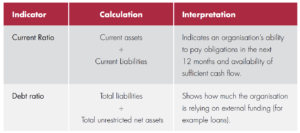
The Statement of Financial Performance displays revenue and expenditures over the course of the financial year. It indicates whether your organisation has generated a surplus or deficit in the reporting period. Revenue is hereby divided into main categories according to the source of funding, in the example it is grants and other income. The second column of the sheet indicates “Note”. Notes are attached to the annual accounts and show a detailed breakdown of the numbers and sources of funding:
Statement of Financial Performance, 2019, Sample Organisation:
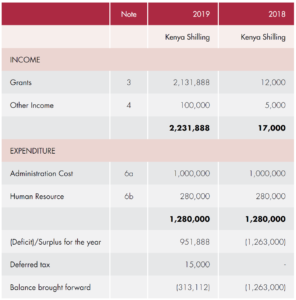
As mentioned, the statement of financial performance is also where more information on different sources of funding can be found. Usually, sources of funding are listed in the notes according to the donor:
Example for “Grants”, Sample Organisation (Note 3):
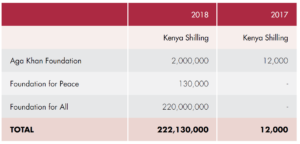
Example for “Other Income”, Sample Organisation (Note 4):
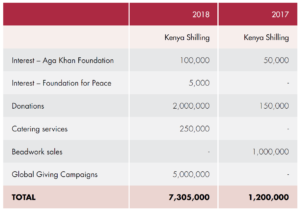
In case your performance sheet has very broad categories with a high revenue such as donations, for example, it is advised to break down the item further with the help of your accountant. This will give you a better overview.
Some financial indicators can help you assess the financial sustainability and the resource mobilisation capacity of your organisation. While most of these indicators are rather technical, they are really good tools for comparing your resource mobilisation efforts over the years.
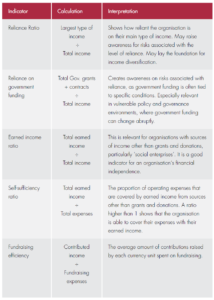
Source: Propel Nonprofits (2000): Analyzing Financial Information using Ratios. Available at https://www.propelnonprofits.org/resources/analyzing-financial-information-using-ratios/, accessed 11/6/2020.
As part of planning for resource mobilisation, the external and internal environment of your organisation needs to be analysed in-depth. PESTLE and SWOT analysis can be used for this.PESTLE Analysis is a tool to track your organisation’s working environment and analyse how different factors influence your organisation.
As part of planning for resource mobilisation, the external and internal environment of your organisation needs to be analysed in-depth. PESTLE and SWOT analysis can be used for this.PESTLE Analysis is a tool to track your organisation’s working environment and analyse how different factors influence your organisation.
PESTLE stands for: P for Political, E for Economic, S for Social, T for Technological, L for Legal and E for Environmental. A PESTLE Analysis is best done in a team workshop, where a corresponding set of questions is asked for each element of PESTLE.
When conducting a PESTLE Analysis, the following questions need to be answered and discussed in-depth:
The SWOT Analysis is an excellent tool to analyse strengths, weaknesses, opportunities and threats to your organisation by visualizing each aspect in quadrants:
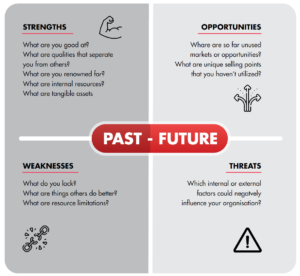
When conducting a SWOT analysis, it is important to record and document different perspectives and opinions of staff, board members and other stakeholders and discuss them openly in a workshop. This will create a deeper understanding for your organisation.
Knowing what other organisations do will help your team build better strategies. By looking at other organisations, you can identify opportunities in the market that are currently under-served. Learning from others, you get further insights and inspiration to inform your own decisions on resource mobilisation methods and messaging.
In a peer organisation analysis, you create an overview about other organisations which work in the same sector, have a similar size or which you think you can learn from. Collect information about them from their website and other documents or by talking to them.
Relevant information includes the peer organisation’s:
Collect the information about the peer organisations and analyse according to the following questions:
Last but not least, an organisational analysis needs to include strategies for resource mobilisation that have been used by your organisation. Often, organisations don’t recognize their resource mobilisation efforts as strategies, as they have been pursued randomly and without clear focus. By structuring and discussing different efforts, you will be able to detect a pattern in your resource mobilisation and take a first step towards planning for resource mobilisation.
In a joint workshop, you and your team can go through each of the categories for resource mobilisation and analyze their application in-depth. The workshop should include all members of staff, from junior to senior management. For each category, the following questions should be asked by a moderator:
Tool 9 Resource Mobilisation Strategies Review.
This tool supports the information collection about the different strategies, how you have used them and how you evaluate their impact.